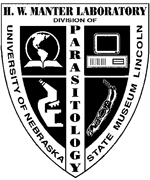Parasitology, Harold W. Manter Laboratory of

Harold W. Manter Laboratory of Parasitology: Library Materials
ORCID IDs
Escalante 0000-0002-1532-3430
Document Type
Article
Date of this Version
8-5-1994
Citation
Proceedings of the National Academy of Sciences of the United States of America (1994) 91(24): 11,373-11,377
doi: 10.1073/pnas.91.24.1137
Abstract
Malaria is among mankind's worst scourges, affecting many millions of people, particularly in the tropics. Human malaria is caused by several species of Plasmodium, a parasitic protozoan. We analyze the small subunit rRNA gene sequences of 11 Plasmodium species, including three parasitic to humans, to infer their evolutionary relationships. Plasmodium falciparum, the most virulent of the human species, is closely related to Plasmodium reiehenowi, which is parasitic to chimpanzee. The estimated time of divergence of these two Plasmodium species is consistent with the time of divergence (6-10 million years ago) between the human and chimpanzee lineages. The falkiparun-reichenowi clade is only remotely related to two other human parasites, Plasmodium malariae and Plasmodium vivax, which are also only remotely related to each other. Thus, the parasitic associations of the Plasmodium species with their human hosts are phylogenetically independent. The remote phylogenetic relationship between the two bird parasites, Plasmodium gallinaceum and Plasmodium lophurae, and any of the human parasites provides no support for the hypothesis that infection by Plasmodium falcipaum is a recent acquisition of humans, possibly coincident with the onset of agriculture.


Comments
License: CC BY-NC-ND